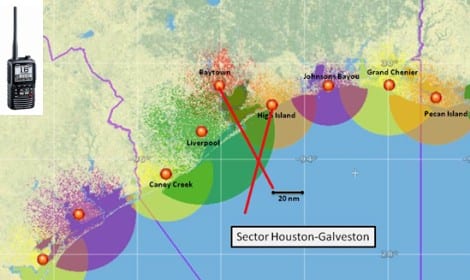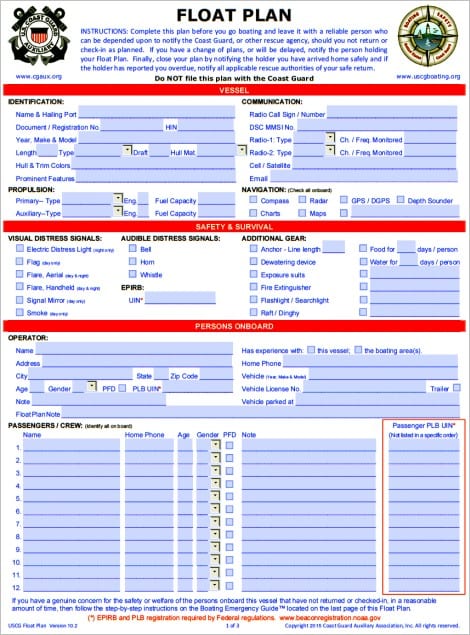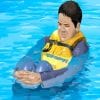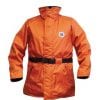 By Bob Currie, Recreational Boating Safety Specialist, United States Coast Guard Auxiliary Station Galveston Flotilla
By Bob Currie, Recreational Boating Safety Specialist, United States Coast Guard Auxiliary Station Galveston Flotilla
What is cold water? Most experts agree that a water temperature below 70 degrees is cold water when the subject is hypothermia. Those of us who are or were scuba divers know that prolonged exposure to water temperatures in the 80s can lead to hypothermia. For the purposes of this column we are talking about accidental immersion in the waters where we live.
The Station Galveston Flotilla of the US Coast Guard Auxiliary operates out of the USCG Station Galveston base on Galveston Island. They aid the Coast Guard by providing maritime observation patrols in Galveston Bay; by providing recreational boating vessel safety checks; and by working alongside Coast Guard members in maritime accident investigation, small boat training, Aids to Navigation verification, in the galley, and watch standing.
Local Temperatures (Galveston Area)
Our coolest water temperature by month usually occurs in January. In the Galveston area, the average water temperature in January is 54 degrees. On average, our local water temperature remains below 70 degrees in the months of November, December, January, February, and March. Today as I write this the water temperature is 54.4 degrees. In the months of December, January, and February the water temperatures remain in the 50s. Water temperatures in the 50s are cold enough to kill a person in the water within 30 minutes, even if they are in the best physical condition. It is not until April that the water temperature nudges above 70 degrees, averaging 71 degrees that month. As hot as our air temperature gets much of the year, we only have four months where the water temperature is in the 80s (June, July, August, and September). May averages 78 degrees and October averages 75 degrees, both of which are cool temperatures that can lead to hypothermia over an extended period. What this means is the first day you swim in the water you are okay. The second day’s exposure adds to the exposure of the first day and you begin to experience some slight symptoms of hypothermia. Three days exposure to water temperatures in the 70s and now you have a mild case of hypothermia. Yes, it is an additive effect, and it does sneak up on you. Today we are talking about sudden accidental immersion in cold water temperatures (below 70 degrees). Before we talk about what to do if you find yourself suddenly immersed in cold water, let’s discuss some ways to minimize your risk.
Boat Preparation
If you are going to go out on the water when the water temperatures are in the 50s, your boat should be in tip-top shape, full of gas, and have all required safety equipment aboard. The engine should be running well, and there should be no leaks in the hull. You should have day and nighttime distress signals. If you are going to leave the sight of shore, distress rockets are highly recommended. The best way to determine if your boat is safe is to undergo a free U.S. Coast Guard Vessel Safety Check. You should have a marine VHF/FM radio aboard, even if you are in a kayak. You can get a handheld one for less than $100. Isn’t your life worth that much? The best place for that handheld marine radio is in a pocket of your life jacket. No pockets on your life jacket? They make pouches you can put your radio in. The point is, it should be on your person. A cell phone is an option, but they are unreliable on the water, and don’t work if they get wet. Spend the money for a floating, waterproof handheld marine radio. It’s cheaper than a casket. A 5-watt handheld marine radio can reach our watchstanders within 21 miles of shore, and we can determine a line of position to you with just a short transmission. All radio calls are recorded, as are positions of boats making distress calls.

Rescue 21 Regional coverage analysis of VHF receive antenna based on geographical line-of-sight. System requirement: At least 20 nm offshore for a 1 watt VHF-FM Ch 16 signal transmitted from two meters above water surface.
File a Float Plan
Filing a float plan doesn’t prevent you from accidental immersion in cold water, but it increases your chance of being rescued in a timely manner. No, you don’t file it with the Coast Guard. We don’t have the personnel to handle them. You file it with a friend or loved one. The Coast Guard app for your cell phone has a float plan that you can file by email with up to three people. You can store your plan and just change the dates and times and people on board. You can also go to our Float Plan Central and learn all about float plans. The USCG Float Plan is a state-of-the-art lifesaving device that is used by search and rescue personnel to assist in reducing the search area in order to locate you in the shortest amount of time possible. It is also the first and only float plan that guides and directs the holder of your float plan on what to do via the exclusive Boating Emergency Guide. Take some time and read about this life-saving procedure at http://floatplancentral.cgaux.org/classroom/floatplans.htm.

Wear a Life Jacket
A boater operating in cold water should always wear a life jacket. Anyone forced to enter the water should button up all clothing, and, if possible, cover his or her head; enter the water slowly;  keep the head out of the water; and assume the heat escape lessening posture (HELP). The HELP position is an attempt to reduce heat loss enough to lessen the effect of hypothermia. It involves essentially positioning one’s knees together and hugging them close to the chest using one’s arms. Furthermore, groups of people can huddle together in this position to conserve body heat, offer moral support, and provide a larger target for rescuers. He or she should also attempt to climb aboard the overturned hull if it is still afloat. The HELP position is demonstrated below:
keep the head out of the water; and assume the heat escape lessening posture (HELP). The HELP position is an attempt to reduce heat loss enough to lessen the effect of hypothermia. It involves essentially positioning one’s knees together and hugging them close to the chest using one’s arms. Furthermore, groups of people can huddle together in this position to conserve body heat, offer moral support, and provide a larger target for rescuers. He or she should also attempt to climb aboard the overturned hull if it is still afloat. The HELP position is demonstrated below:
Swim or Stay with the Boat Dilemma
We all know that when it is cold outside and we aren’t quite dressed warmly enough we can get the blood flowing and stave off the cold by exercising; that is, swinging our arms, walking in place, anything to get the blood flowing and warm the body. The problem is, while this works in air, cold water cools the body 32 times faster than cold air, and moving around in the water makes it worse. You have to make a choice if you find yourself accidentally immersed in cold water, and that is whether to try to swim for shore or stay with the boat. Unless you are close to shore, you need to think about staying still in the HELP (heat escape lessening posture) position. Alternatively, you can hold onto your overturned boat, and if it is small enough, push it towards shore. This method is one you can use with a kayak if you are unable to re-board it. If you are boating when the water temperature is cold, try to remain as close to shore as possible, especially if you are in a small boat.
Dress for Immersion
Have you ever heard of a float coat? It is a type III life jacket that is designed to protect your upper body in cold water.  Whenever the water temperature is below 60 degrees, we in the Coast Guard are required to wear an immersion survival suit which covers the entire body. They aren’t cheap, but a float coat is a reasonably priced option that dramatically increases your chances of surviving an accidental immersion. If you don’t have one, then at least wear some layered synthetic clothing. Cotton is the worst thing you can wear. It is a very poor insulator.
Whenever the water temperature is below 60 degrees, we in the Coast Guard are required to wear an immersion survival suit which covers the entire body. They aren’t cheap, but a float coat is a reasonably priced option that dramatically increases your chances of surviving an accidental immersion. If you don’t have one, then at least wear some layered synthetic clothing. Cotton is the worst thing you can wear. It is a very poor insulator.
Know What to Expect if You Are Accidentally Immersed
The first thing that may happen to you is a phenomenon called the Gasp Reflex. When you hit cold water the body tends to react by gasping, and this is when many people inhale a large amount of water. If this happens and you aren’t wearing a life jacket, your chance of survival is zero. If you are wearing a life jacket that holds your head above water, you may be able to cough up the water. Within just minutes of immersion, your body tries to keep its core temperature by pulling blood from your extremities. That means that almost right away your fingers grow numb and you cannot grasp a rope thrown to you. A few minutes more and you can no longer move your arms to tread water. Your feet hang down and you are unable to move them. You go into shock within a few more minutes, and at this point many older persons undergo cardiac arrest. If your boat is still floating but capsized, the best thing you can do is try to pull yourself onto the boat. Get as much of your body out of the water as possible.
The Mammalian Diving Reflex
Most persons recovered in cold water near-drowning cases show the typical signs of death: blue skin coloration, no detectable breathing, no apparent pulse or heartbeat, and pupils fixed and dilated. These symptoms, it was discovered, don’t always mean the victim is dead. Instead, the persons had undergone a change to their bodies called the mammalian diving reflex, in which the body diverts blood away from the arms and legs to circulate at the rate of only 6-8 beats per minute, with blood flowing only to the heart, brain and lungs. This reflex is what whales and other marine mammals use to stay down as long as 30 minutes underwater. In humans the reflex is seen when the water temperature is less than 70 degrees. The colder the water, the more profound the reaction. The reflex is seen more often in younger persons and is dependent on facial immersion in cold water. The key to survival is recognition by the rescuer that the person may not be dead and quick activation of CPR.
Summary
Boating in the winter months when water temperatures are below 70 degrees is a dangerous prospect if you are not prepared. Your boat should be in tip-top condition. You should file a float plan, carry a marine VHF/FM radio, always wear your life jacket when in your boat, and dress for immersion.
For more information on boating safety, please visit the Official Website of the U.S. Coast Guard’s Boating Safety Division at www.uscgboating.org. Questions about the US Coast Guard Auxiliary or our free Vessel Safety Check program may be directed to me at [email protected]. I am available to perform free Vessel Safety Checks, and I will come to your location to perform them. SAFE BOATING!
[Jan-27-2020]

 Posted in
Posted in 























